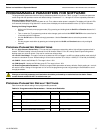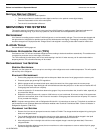
Eskimo Ice Installation & Operation Manual TROUBLESHOOTING GUIDE
L-3152 ENGLISH 21
REFRIGERANT GAS
The refrigerant included in the system is adequate for the life of the system and should not need routine or seasonal charging. If
the need exists for routine charging, have your dealer look for a refrigerant leak that needs repair.
WATER RESERVOIR
If water reservoir is fouled or contaminated, refer to “Evaporator Cleaning” on page 20 and follow that cleaning procedure, as
the water reservoir is a window to your evaporator’s condition.
FEEDWATER FILTER AND Y STRAINER
Change the filter at least twice per year, or every 1500 gallons, whichever comes first. The correct filter helps prevent clogging
of the needle valve and scale buildup within the evaporator chamber. Occasionally check the Y strainer and clean away any
debris.
WINTERIZING THE SYSTEM
Close the seacock and remove the inlet hose from the condensing unit. Allow all water to drain from the system. Loosen screws
on the pump head to allow water to drain from the pump. Cutoff feedwater supply, and drain the unit. Remove water from the
water reservoir inside the unit. You may also add non-toxic antifreeze to the water reservoir.
Use a shop wet-vac to remove the water from the evaporator through the ice discharge spout tube, or remove the water tank
assembly from the spout and drain it.
TROUBLESHOOTING GUIDE
Before calling for service, review this list. It may save time and expense. This list contains common occurrences that are not a
result of defective workmanship or materials.
If you still need service after trying these procedures, call your local dealer or the Dometic Group Marine Division service
department at +1 954-973-2477 (Monday through Friday, 8AM - 5PM US Eastern Time) or +1 888-440-4494 (Evenings and
weekends US Eastern Time).
PROBLEM POSSIBLE REASONS & SOLUTIONS
Unit does not operate at all. 1. Power switch in the “Off” position. Press power switch to turn the unit on.
2. Check for tripped breaker or blown fuses.
3. Significantly low voltage to unit.
4. Misconnected or loose plugs or wiring.
High-pressure fault.
(HPF)
1. Check seawater system for clogs, air trap, faulty pump, dirty strainer, or condenser in need of
descaling.
2. Faulty pump relay trigger at relay station (if pump is used for more than one unit). Replace
trigger.
Low-pressure fault.
(LPF)
1. Low refrigerant charge. Have a certified technician check the pressure.
2. Improperly set Thermal Expansion Valve (TXV). If under warranty, call for authorization before
adjusting TXV, otherwise warranty will be voided.
Ice-clog
(OCA)
1. Check for obstruction at the ice discharge in the ice-storage box.
2. Check for frozen ice-delivery hose.
3. Check routing for dips or kinks in the ice-delivery hose.
4. Check for auger motor failure.
5. Check for auger vent clog.
Feedwater fault.
(H2O)
1. Check water pressure in boat’s potable water system.
2. Check for a supply valve that has been turned off.
3. Check for a clogged feedwater filter.
4. Check for a cloged Y strainer located on the feedwater line of the unit.
5. Check for a clogged needle valve in the water reservoir.


















